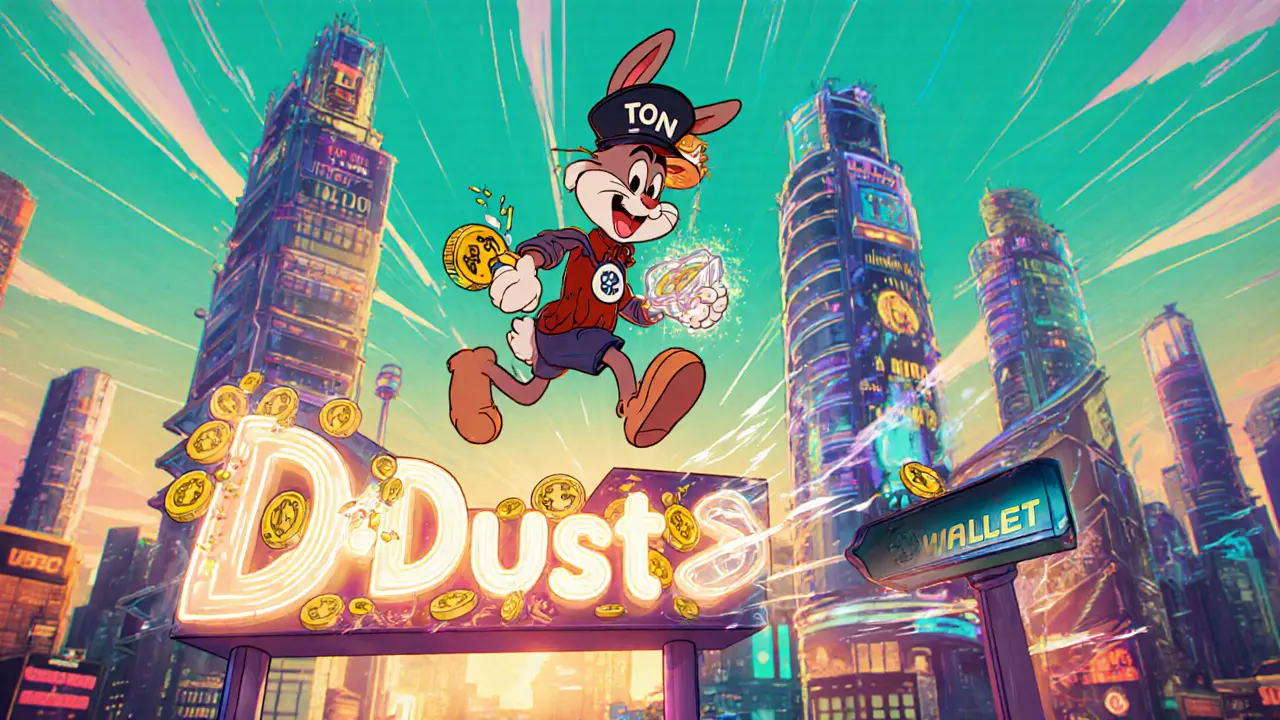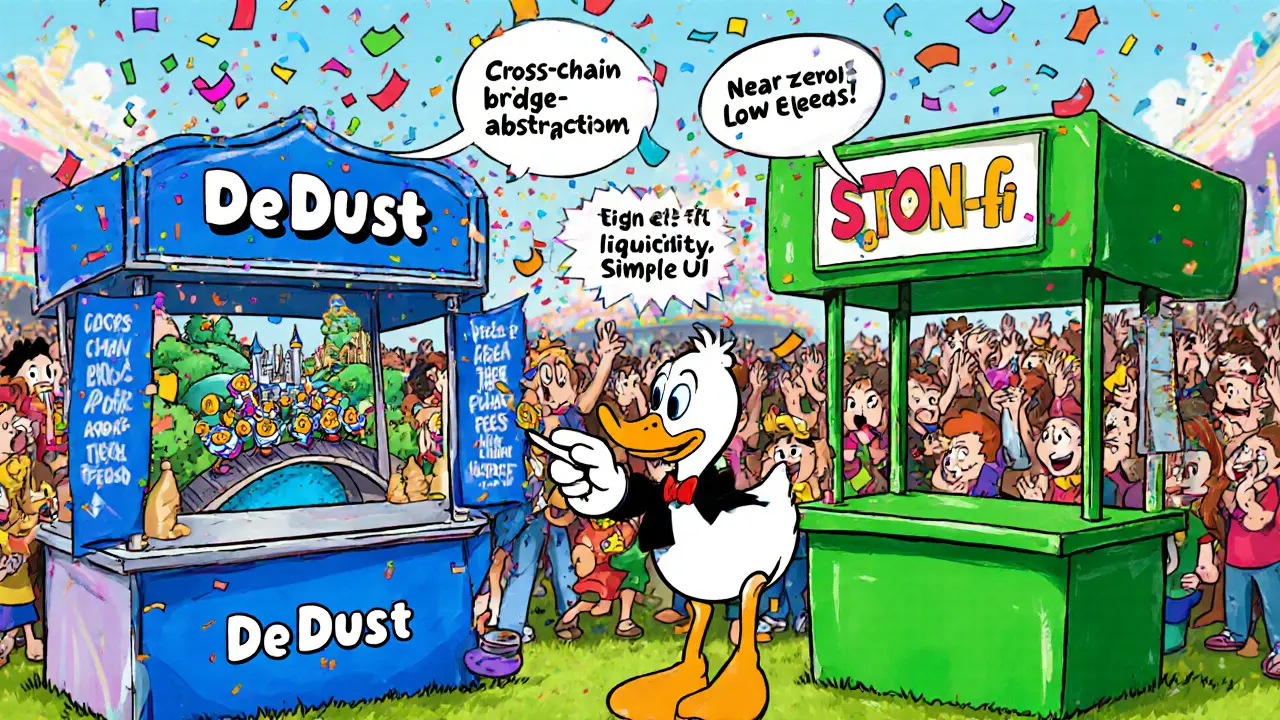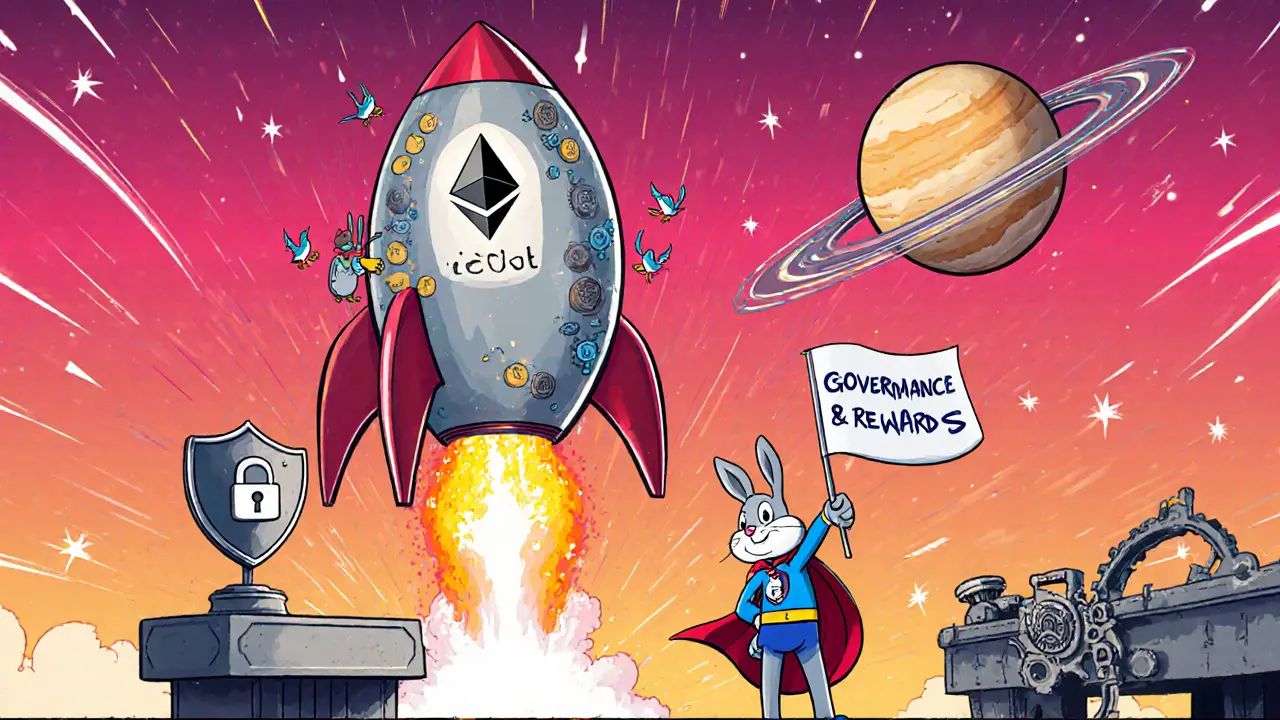
DeDust DEX Feature Comparison Tool
DeDust
TON-native DEX with advanced features including cross-chain bridge and asset abstraction.
- Cross-chain bridge to Ethereum
- Asset abstraction module
- Extensible protocol
- Governance token: SCALE
STON.fi
Simpler, faster TON-only DEX with high liquidity for core assets.
- No cross-chain bridge
- Basic AMM design
- Limited extensibility
- Governance token: STON
Detailed Feature Comparison
| Feature | DeDust | STON.fi |
|---|---|---|
| Protocol Version | DeDust Protocol 2.0 | Custom AMM |
| Cross-chain Bridge | Ethereum ↔ TON | None |
| Fees | Low (~0.2%) | Near-zero fees |
| Liquidity Depth | ~$14K (DUST) | ~$30K (core pools) |
| Wallet Integration | Tonkeeper, MyTonWallet, Telegram | Tonkeeper, MyTonWallet |
| Governance Token | SCALE | STON |
| Asset Abstraction | Yes | No |
DeDust Strengths
- Advanced technical architecture
- Cross-chain bridge to Ethereum
- Robust tokenomics with SCALE
- Extensible protocol design
STON.fi Strengths
- Simplified user interface
- High liquidity for core pairs
- Lower entry barrier
- Fast transaction speeds
Which Should You Choose?
Choose DeDust if you value technical depth, cross-chain capabilities, and governance participation. Choose STON.fi if you prioritize simplicity, speed, and high liquidity for core TON assets.
Both platforms leverage TON's sharding technology for fast, low-cost transactions.
Quick Take:
- DeDust is a TON‑native DEX built on Protocol2.0, offering fast, low‑fee swaps.
- The platform’s native token, SCALE, powers governance and rewards.
- Features include a cross‑chain bridge to Ethereum and a Telegram mini‑app.
- Competes directly with STON.fi; DeDust wins on technical depth, STON.fi wins on simplicity.
- Security hinges on TON’s sharding model but smart‑contract bugs and bridge risks remain.
When you search for a "DeDust crypto exchange review", you expect a clear picture of what the platform does, how to use it, and whether it’s worth your time. Below you’ll find a step‑by‑step walkthrough, a look at the economics of the SCALE token, a side‑by‑side comparison with the main rival, and a realistic assessment of risks and future prospects.
What Is DeDust?
DeDust is a decentralized exchange (DEX) that runs natively on the TON (The Open Network) blockchain. Launched with the DeDust Protocol2.0, the platform leverages TON’s sharding architecture to deliver near‑instant swaps with minimal gas costs. Users interact through the official website (dedust.io), compatible wallets, or a Telegram mini‑app.
How DeDust Works - The Technical Backbone
The heart of the exchange is DeDust Protocol 2.0. Unlike a basic automated market maker, Protocol2.0 adds extensibility layers, an asset‑abstraction module, and a built‑in cross‑chain bridge. The architecture follows object‑oriented principles: contracts are abstracted, allowing new token types to be added without rewriting core logic.
Key technical highlights:
- Sharding on TON enables parallel transaction processing, boosting throughput.
- Gas‑optimized smart contracts keep fees low compared to Ethereum‑based DEXs.
- Asset abstraction lets the same contract handle TON‑based tokens, wrapped Bitcoin (WBTC), and major stablecoins (USDC, USDT, DAI) in a unified pool.
Getting Started - A Walkthrough
Using DeDust is straightforward if you already have a TON‑compatible wallet. The most popular choices are Tonkeeper and MyTonWallet. Follow these steps:
- Download Tonkeeper or MyTonWallet from the official app store.
- Create a new wallet or import an existing one using your seed phrase.
- Fund the wallet with TON or any supported token (e.g., USDC). Use the “Deposit” button inside the wallet to generate a TON address.
- Visit dedust.io and click “Connect Wallet”. The site uses TON Connect, so the wallet will prompt you to approve the connection.
- Once connected, the trading interface displays available pools. Select a pair, enter the amount, and confirm the swap. The transaction confirms in seconds thanks to TON sharding.
- To provide liquidity, click “Add Liquidity”, choose a pool, and deposit equal values of the two assets. You’ll receive LP tokens that accrue a share of fees plus SCALE rewards.
If you prefer a social‑media environment, the Telegram mini‑app is reachable via the official DeDust bot. Note that, as of mid‑2024, the Telegram version still shows occasional glitches, so the web or wallet‑based UI is more reliable.
Tokenomics - The Role of SCALE
The platform’s native governance and reward token is SCALE. As of October2025, SCALE trades around $1.37 USD, up 8.5% in the previous 24hours, with an all‑time high of $11.76. SCALE serves three core purposes:
- Governance: Holders can vote on protocol upgrades, fee structures, and new asset listings.
- Liquidity Incentives: LPs earn a portion of swap fees plus a daily allocation of newly minted SCALE.
- Staking Rewards: Users can lock SCALE in the staking contract to earn additional tokens and boost their voting weight.
Token distribution is transparent: 40% to the community (liquidity mining and staking), 20% to the development fund, 20% to founders and early contributors, and 20% reserved for future ecosystem grants.

Security and Risk Assessment
DeDust inherits many security guarantees from the TON blockchain, including cryptographic validation of each shard and fast finality. However, DeDust also faces the typical DeFi risk profile:
- Smart‑contract bugs: Any vulnerability in the core AMM or bridge contracts could expose funds.
- Bridge attack vectors: The Ethereum‑TON bridge adds complexity; cross‑chain exploits have been observed on other platforms.
- Liquidity risk: With daily trading volume hovering around $14K for the DUST token, shallow pools may experience high slippage.
- Phishing threats: The project warns about fake websites and Telegram bots, a common issue in the crypto space.
Best practices include using only the official website, verifying wallet addresses, and limiting bridge transfers to amounts you’re comfortable losing in worst‑case scenarios.
DeDust vs. STON.fi - Quick Comparison
| Feature | DeDust | STON.fi |
|---|---|---|
| Protocol version | DeDust Protocol2.0 (extensible, asset‑abstraction) | Custom AMM (simpler design) |
| Cross‑chain bridge | Ethereum ↔ TON (WBTC, USDC, USDT, DAI) | None (TON‑only) |
| Fees | Low, gas‑optimized (≈0.2% avg.) | Near‑zero fees advertised |
| Liquidity depth (24h) | ≈$14K (DUST token) | ≈$30K (major pools) |
| Wallet integration | Tonkeeper, MyTonWallet, Telegram mini‑app | Tonkeeper, MyTonWallet |
| Governance token | SCALE | STON token |
DeDust wins on technical breadth-especially the bridge and asset abstraction-while STON.fi offers a cleaner UI and higher liquidity for core TON pairs. Your choice depends on whether you need cross‑chain capability or simply want the smoothest swapping experience.
Pros and Cons
Pros
- Fast, sharding‑based transaction confirmation.
- Low gas fees thanks to TON’s design.
- Cross‑chain bridge opens Ethereum assets to TON users.
- Robust tokenomics with governance, staking, and liquidity rewards.
- Open‑source smart contracts allow community audits.
Cons
- Liquidity still limited compared to major DEXs.
- Telegram mini‑app unstable for high‑volume traders.
- Bridge introduces extra security surface.
- TON ecosystem is younger; market depth and tooling are still maturing.
Future Outlook
DeDust’s roadmap highlights three focus areas: stabilizing the Telegram interface, expanding the Ethereum‑TON bridge to include additional assets (e.g., wrapped ETH), and deepening liquidity through partnerships with TON‑based projects. If the TON network achieves broader adoption-driven by its association with the Telegram community-DeDust could become the default gateway for cross‑chain DeFi on that layer.
In the meantime, the platform remains a solid choice for users already invested in TON or those who need to move assets between Ethereum and TON without paying Ethereum gas fees. Keep an eye on upcoming bridge audits and community governance votes; those events will signal how quickly DeDust matures.

Frequently Asked Questions
Frequently Asked Questions
Is DeDust safe to use?
DeDust inherits security from the TON blockchain, which uses sharding and strong cryptography. However, smart‑contract bugs and bridge exploits are possible. Always use the official website, audit the contracts if you can, and only move amounts you’re willing to risk.
How do I connect my wallet?
Open Tonkeeper or MyTonWallet, fund it with TON, then click “Connect Wallet” on dedust.io. The wallet will prompt you to approve the connection via TON Connect.
What assets can I trade on DeDust?
Any token native to TON plus wrapped assets from the Ethereum bridge (WBTC, USDC, USDT, DAI). New assets can be added through the protocol’s abstraction layer.
How does the CROSS‑CHAIN bridge work?
The bridge locks the original token on the source chain (e.g., ETH on Ethereum) and mints a wrapped counterpart on TON. When you withdraw, the wrapped token is burned and the original is released.
What is the role of the SCALE token?
SCALE powers governance, rewards liquidity providers, and can be staked for extra yields. Holding SCALE gives you voting rights on protocol upgrades.

Katrinka Scribner
June 1, 2025 AT 11:15Wow DeDust looks shiny! 😍
VICKIE MALBRUE
June 4, 2025 AT 13:15This review really lifts the mood about TON DEXs – good stuff
Naomi Snelling
June 7, 2025 AT 15:15Anyone talking about the cross‑chain bridge should remember that every extra hop is a new attack vector. The Ethereum‑TON bridge is still experimental and could be a backdoor for malicious actors. I've seen similar bridges get drained overnight, and the lack of transparent audits makes me uneasy. People love the low fees, but low fees often hide hidden risks. Stay skeptical and move only what you can afford to lose.
Billy Krzemien
June 10, 2025 AT 17:15If you’re new to DeDust, start by installing Tonkeeper or MyTonWallet. Fund the wallet with a modest amount of TON to cover transaction fees. Connect the wallet on dedust.io and double‑check the URL to avoid phishing sites. Follow the on‑screen prompts to approve the connection via TON Connect. Once connected, you can explore pools, swap tokens, or add liquidity with confidence.
april harper
June 13, 2025 AT 19:15DeDust is a fascinating experiment in abstraction, a mirror reflecting our desire to compress complexity into simplicity. Yet, beneath its sleek UI lies a web of contracts that could unravel with a single flaw. The bridge, while alluring, reminds us that every convenience comes at a price. I find myself torn between admiration for its ambition and dread of its fragility. Perhaps the future will judge it more kindly than we do today.
Somesh Nikam
June 16, 2025 AT 21:15Great breakdown! 👍 DeDust’s low‑fee model really shines for everyday traders. The asset‑abstraction feature opens doors for wrapped Bitcoin and stablecoins, which is a big plus. Keep an eye on the bridge audits; once they’re solid, confidence will soar. Looking forward to seeing the liquidity pools grow!
Courtney Winq-Microblading
June 19, 2025 AT 23:15Reading this feels like watching a sunrise over a digital horizon. DeDust’s protocol depth is like a hidden reef teeming with life, waiting for explorers. I appreciate the blend of tech elegance and community governance. Let’s hope the ecosystem nurtures that reef instead of mining it away.
katie littlewood
June 23, 2025 AT 01:15When I first encountered DeDust, I was struck by the sheer ambition encoded in its Protocol 2.0. The cross‑chain bridge to Ethereum isn’t just a feature; it’s a statement that TON can converse with the broader crypto world. This opens up arbitrage possibilities that were previously inaccessible to TON‑only traders. Moreover, the asset‑abstraction layer means that wrapped assets like USDC and WBTC can be treated as first‑class citizens, simplifying liquidity provision. The governance token SCALE provides a tangible hook for users to participate in protocol upgrades, aligning incentives across the community. While the current liquidity depth of around $14 K may seem modest, it signals a growing interest that could snowball as more projects integrate. The low fee structure, hovering near 0.2 %, makes micro‑trades viable, encouraging a higher turnover and, consequently, a healthier ecosystem. The inclusion of a Telegram mini‑app is a clever nod to the platform’s user base, though it still needs polishing. Security remains a double‑edged sword; while TON’s sharding offers fast finality, the bridge adds a surface area that must be hardened through rigorous audits. Overall, DeDust stands as a compelling option for users who value technical depth and cross‑chain functionality, even if they must tolerate a slightly steeper learning curve compared to the more straightforward STON.fi.
Jenae Lawler
June 26, 2025 AT 03:15It is with a measured degree of scholarly skepticism that I assess DeDust’s purported superiority. While the documentation extols its extensibility, one must inquire whether such flexibility does not betray an architectural over‑engineering that could impede robustness. The bridge, lauded for its cross‑chain ambition, equally invites speculation regarding systemic vulnerabilities. One might argue that the minimal liquidity renders the platform susceptible to price manipulation, a concern scarcely addressed in the review. In sum, the platform’s avant‑garde aspirations merit cautious appraisal rather than celebratory endorsement.
Chad Fraser
June 29, 2025 AT 05:15Yo, DeDust is fire! The bridge gives you that extra mojo to swing assets between ETH and TON without the crazy gas. Low fees mean you can flip more often and actually make some gains. Jump in, add liquidity, and let those SCALE tokens rain on you. Let’s get those gains rolling!
Jayne McCann
July 2, 2025 AT 07:15DeDust sounds fancy but I’ll stick with the simpler DEXs.
Richard Herman
July 5, 2025 AT 09:15Both DeDust and STON.fi have their merits, and the best choice depends on individual priorities. If cross‑chain access and deeper protocol features matter, DeDust shines. For those who prefer a smoother UI and higher core liquidity, STON.fi might be the way to go. It’s valuable for the community to have diverse options that cater to different use cases. Ultimately, healthy competition will drive improvements across the TON ecosystem.
Parker Dixon
July 8, 2025 AT 11:15Interesting take on DeDust’s architecture, but I’d like to add a technical nuance. The bridge’s security model relies heavily on multi‑sig contracts and periodic audits, which mitigate many of the risks you mentioned. Moreover, the LP reward curve is designed to incentivize early liquidity providers, gradually adjusting as depth increases. 📈 Users should also monitor the upcoming governance proposals, as they could introduce fee optimizations. Overall, while caution is warranted, the platform’s roadmap shows promising steps toward maturity.